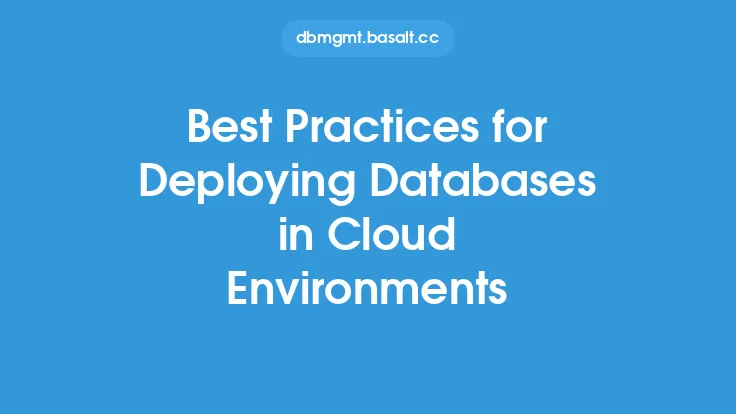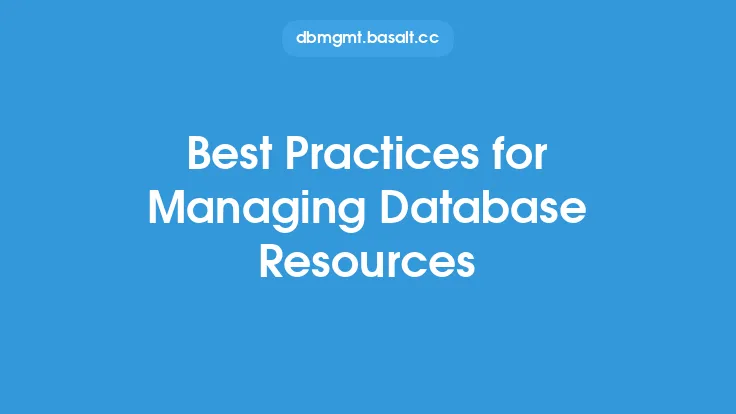When it comes to scaling database workloads, there are several best practices that can help ensure a smooth and efficient process. One of the most important things to consider is the database design itself. A well-designed database will be able to handle increased traffic and data storage without a significant decrease in performance. This can be achieved by using techniques such as normalization, which helps to eliminate data redundancy and improve data integrity. Additionally, using indexing and caching can help to improve query performance and reduce the load on the database.
Understanding Database Scalability
Database scalability refers to the ability of a database to handle increased traffic and data storage without a significant decrease in performance. There are several types of scalability, including vertical scalability, which involves increasing the power of a single server, and horizontal scalability, which involves adding more servers to the system. Understanding the type of scalability that is needed is crucial in determining the best approach to scaling a database workload. For example, if a database is experiencing high traffic, adding more servers to the system may be the best solution, while if a database is experiencing high data storage needs, increasing the power of a single server may be more effective.
Choosing the Right Database Management System
The choice of database management system (DBMS) can also have a significant impact on scalability. Different DBMSs have different strengths and weaknesses when it comes to scalability, and some are better suited to handling high traffic or large amounts of data. For example, relational databases such as MySQL and PostgreSQL are well-suited to handling high traffic and complex transactions, while NoSQL databases such as MongoDB and Cassandra are better suited to handling large amounts of unstructured data. Additionally, some DBMSs such as Oracle and Microsoft SQL Server offer advanced features such as parallel processing and distributed queries that can help to improve scalability.
Implementing Sharding and Partitioning
Sharding and partitioning are two techniques that can be used to improve scalability in databases. Sharding involves dividing a database into smaller, more manageable pieces called shards, each of which contains a portion of the overall data. This can help to improve performance by allowing queries to be executed in parallel across multiple shards. Partitioning, on the other hand, involves dividing a database into smaller pieces based on a specific criteria, such as date or location. This can help to improve performance by allowing queries to be executed on a specific partition, rather than on the entire database.
Using Load Balancing and Caching
Load balancing and caching are two techniques that can be used to improve scalability in databases. Load balancing involves distributing incoming traffic across multiple servers, which can help to improve performance by preventing any one server from becoming overwhelmed. Caching, on the other hand, involves storing frequently accessed data in a faster, more accessible location, such as RAM. This can help to improve performance by reducing the number of queries that need to be executed on the database. Additionally, caching can help to reduce the load on the database by storing frequently accessed data in a location that is closer to the user.
Monitoring and Optimizing Performance
Monitoring and optimizing performance is crucial in ensuring that a database is running at optimal levels. This can be achieved by using tools such as query analyzers and performance monitors, which can help to identify bottlenecks and areas for improvement. Additionally, optimizing database configuration and parameters, such as buffer pool size and sort size, can help to improve performance. Regular maintenance tasks, such as indexing and statistics gathering, can also help to improve performance by ensuring that the database is running efficiently.
Using Cloud-Based Services
Cloud-based services can provide a scalable and on-demand infrastructure for databases, allowing businesses to quickly scale up or down to meet changing needs. Cloud-based services such as Amazon RDS and Google Cloud SQL provide a managed database service, which can help to reduce the administrative burden of managing a database. Additionally, cloud-based services such as Amazon Aurora and Google Cloud Spanner provide a scalable and high-performance database service, which can help to improve performance and reduce latency.
Implementing Automation and Orchestration
Automation and orchestration can help to improve scalability in databases by automating routine tasks and providing a framework for managing complex workflows. Automation tools such as Ansible and Puppet can help to automate tasks such as database provisioning and configuration, while orchestration tools such as Kubernetes can help to manage complex workflows and provide a framework for scaling databases. Additionally, automation and orchestration can help to improve performance by providing a framework for managing resources and optimizing database configuration.
Best Practices for Scaling Database Workloads
In conclusion, scaling database workloads requires a combination of good database design, choosing the right DBMS, implementing sharding and partitioning, using load balancing and caching, monitoring and optimizing performance, using cloud-based services, and implementing automation and orchestration. By following these best practices, businesses can ensure that their databases are running at optimal levels and are able to handle increased traffic and data storage without a significant decrease in performance. Additionally, by using the right tools and techniques, businesses can improve performance, reduce latency, and provide a better user experience.





